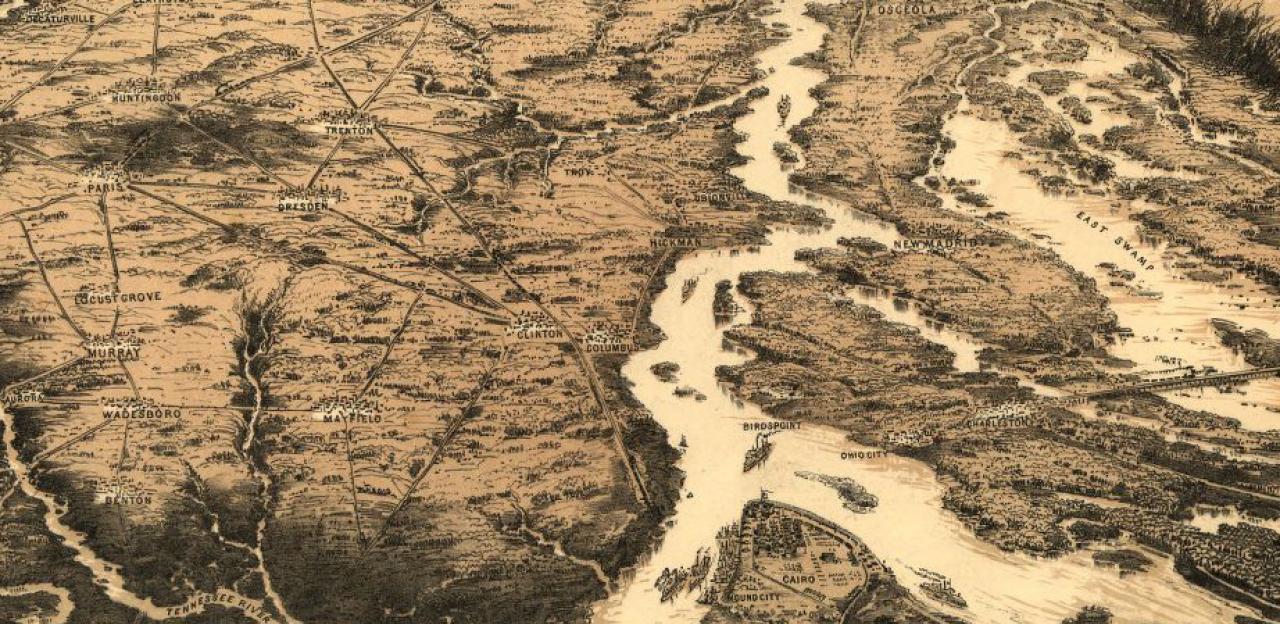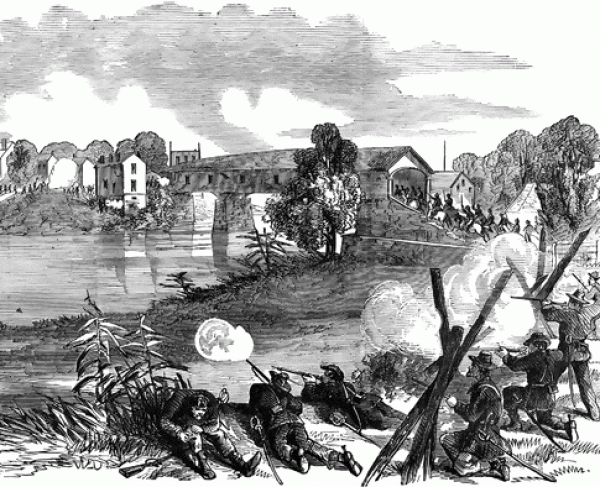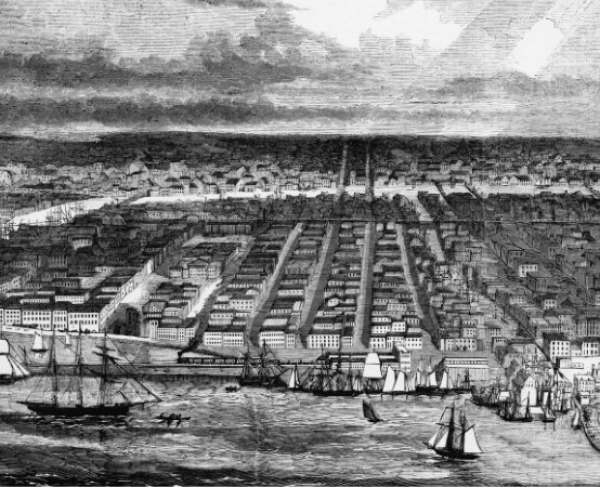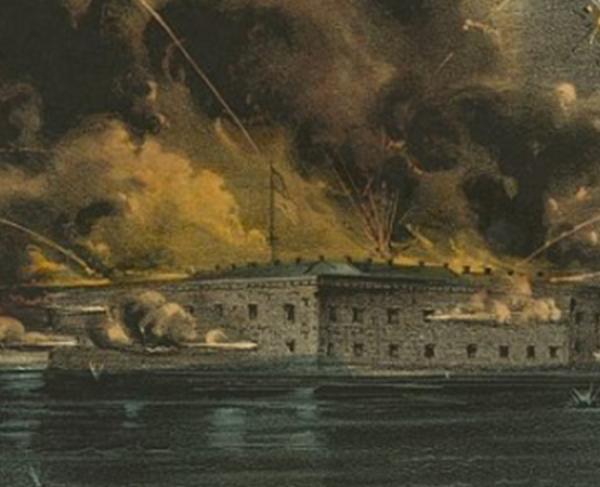A War Anything but Civil

By Benjamin Franklin Cooling
A surrendered Southern major from Tennessee, Nathaniel Cheairs recorded Fort Donelson as “the most disgraceful, unnecessary and uncalled for surrender that occurred during the four years of the War.” Catching the temper of the doomed garrison, his sentiment has echoed through the years of Lost Cause litany.
The meaning of the surrender of Forts Henry and Donelson cannot be measured by casualties alone. True, the equivalent of a corps of rebels, some 12,000–15,000 (Civil War figures are always suspect) who went north to Union prison compounds made a significant dent in Gen. Albert Sidney Johnston’s western department resources. The chessboard of war was significantly altered by inept Confederate leadership and poorly calculated decisions at the general officer level, both locally and up to theater command. Yet, it was Johnston alone who yielded the key upper heartland states of Kentucky and Tennessee through precipitous retreat following the loss of the twin river posts and their garrisons. Neither he nor the Confederacy ever regained them; the dream of establishing a northern frontier of the new nation on the banks of the Ohio River died on the Tennessee and Cumberland Rivers in February 1862.
Johnston hardly merited Confederate president Jefferson Davis’s opinion that his old friend was the greatest living soldier of his time. Johnston was simply ill-equipped to handle so large an assignment, a task made doubly difficult by inadequate resources and the necessity of using static defense of river forts like Henry and Donelson absent a navy. Moreover, his covey of inept subordinates was thrust together in a dysfunctional relationship given to poor decision-making and contradictory actions. Why Sidney Johnston did not go to personally lead and fight the decisive battle on the Twin Rivers after the fall of Fort Henry and before the catastrophe at Fort Donelson will never be known. After all, a Yankee bullet at Shiloh two months later spared him any fall from grace among the pantheon of Confederate leaders. For the South, about the only bright spot to emerge from the Tennessee/Cumberland River disasters was an unknown colonel — Nathan Bedford Forrest — who rode out of the trap and on to that lofty pantheon. But, we know this now. At the time, nobody could possibly have sensed that outcome.
The same may be said of the new star rising on the Union horizon — Brig. Gen. Ulysses S. Grant. With the sobriquet “Unconditional Surrender,” fashioned from his initials in the Northern elation following his much-appreciated victories, Grant began his road to the White House in the winter snows of the two rebel forts. Yet, like Bedford Forrest, we know this now, his contemporaries could not. In fact, Grant’s superior, Maj. Gen. Henry Halleck, seemingly did all he could thereafter to stifle such progression. Therein lies part of the answer to the next question: Unimpeded, could Grant and his Midwestern soldiery have pressed on after Forts Henry and Donelson, splitting asunder this experiment in rebellion and ending the war that subsequent spring and summer? Could that have been the outcome; could they have exploited their success as Johnston and his second-in-command, Maj. Gen. William J. Hardee, dejectedly plodded through rain and mud with a greatly diminished Central Army of Kentucky to regroup in northern Mississippi? Or might Johnston have reversed Grant’s success at this point by denying the victors entry to Tennessee’s capital, Nashville?
The capture of that city on February 24, 1862 — the first rebel state capital to fall — plus the evacuation of fortress Columbus on the Mississippi River on March 2 and the eclipse of secessionist hopes in conquered Tennessee and Kentucky all resulted from the events at Forts Henry and Donelson. In fact, since Grant’s was a joint Army-Navy operation, Union gunboats ranged all the way up the Tennessee River to Muscle Shoals in north Alabama, thus opening an inviting invasion route to complete conquest of what might be seen as the Confederacy’s western breadbasket — an area absolutely indispensable for what ultimately turned into a long war.
All this constituted Forts Henry and Donelson’s immediate legacy. Yet, why did these early victories of Grant and the Union transform into an unanticipated long war? Why could they not exploit their battlefield success and their command of steam propulsion on river and rail to rapidly dismantle the southern Confederacy in 1862? To use today’s terminology, how did the legacy of Forts Henry and Donelson within months also become a legacy of military occupation, stabilization and reconstruction while major fighting continued on battlefields or against cavalry raiders, partisan guerrillas and a decidedly unsubdued, hostile populace?
Insightful historians point to the impossibility of making “the first battle,” or any other single clash during the Civil War–era, that annihilative armageddon so desired by professional soldiers. In the case of post- Henry and Donelson, the reasons lie in both structural and personality weaknesses, as well as strategy. The Union army had divided its Western Theater into two departments — the Missouri, under Halleck, and the Ohio, under Maj. Gen. Don Carlos Buell. The two men were rivals, and Halleck used the Henry-Donelson victory to request that the two commands be combined under his leadership, a suggestion refused by Washington at the time but ultimately followed with the creation of the Department of the Mississippi in late March. While initially strong, the relationship between Halleck and Grant grew strained, eventually culminating with the latter’s brief removal from field command citing concerns over renewed alcoholism.
The nature of the Union’s divisive strategy — three-pronged offensives through the upper heartland and down the Mississippi Valley via river, rail and road to invade and subdue western Dixie — also prevented swift, decisive victory. Capture of Nashville was easy, but what next? It is unlikely Johnston could have mounted a defense north of the Alabama–Mississippi boundary in Tennessee after Donelson’s loss. For the Union, however, the subsequent move — a measured, studied approach to opening the Father of Waters (surely the primary thrust of all national effort in the west for political and commercial reasons) — was the product of structured West Point training and thought. Operations in Middle and West Tennessee looked to outflank Confederate river strong points southward toward Memphis and all the way to the Gulf, or to circumvent the daunting prospect of approaching Chattanooga — a vital rail center and the gateway to Georgia and the sea beyond — across the barren Cumberland Plateau. Still, advantages of numbers and momentum seemingly lay with the Yankees after Henry-Donelson. Why did they permit such initiative to slip from their grasp?
The prospect of Union victory in 1862 depended upon innovative, aggressive generalship. Subordinates like Grant, navy Flag Officer Andrew Hull Foote and perhaps others like William T. Sherman, or even John Pope, were constricted by their conservative superiors. Halleck was too jealous and mistrusting of his modest, retiring, somewhat lack-luster (if successful) subordinate Grant and his peer competitor Buell, who in turn fretted too much about prerogatives and an invisible enemy, while both commanders protested the lack of resources. In this case, instead of caution being thrown to the wind, the Union allowed it to stunt any further drive based on past successes.
Nevertheless, modern analysis of results must consider factors other than traditional explanations. Logistics, uncertainty, even climatology were impediments to speed that winter. Dispersal of effort demanded the tripling of human and material resources for the Union effort. Reconstitution of force after a winter expedition that was especially costly to the Union river flotilla, as well as mobilization of new manpower levies and additional material resources took time. Army movements depended upon quantities of transport boats, railroad rolling stock and mundane tools like horses, mules and wagons. The eternal question of “how much is enough,” the balance of competing priorities from other sectors and theaters, plagues military operations even today.
However unglamorous these issues may seem, they cannot be dismissed as part of the immediate Forts Henry and Donelson legacy. Ill-considered by historical explanation since then is how the climatological effects of snow melt and winter rains — seen plainly by the flooded Tennessee at the time of Fort Henry — and plain mud impacted soldiers and equipment, attitudes and movement or the odds of exploiting tactical and operational victory or defeat. Both armies necessarily had to expend the weeks after Henry-Donelson re-grouping, mustering and marshaling anew for what was to come. Johnston adroitly concentrated resources from across the shrinking western Confederacy at Corinth. His opponents seemingly frittered away the chance for decisive action by slowly chipping away at the vast stretch of territory from Nashville to Pittsburgh Landing to the Mississippi above Memphis. Arguably, what emerges, then, is a military picture that somewhat tarnishes the impression that the war could be easily ended in the spring.
It could be postulated that two roads forward in time divided in the woods after Fort Donelson. Circumstances of the one led directly to the next meeting, confrontation and great battle at Shiloh. But was that fight preordained to happen or mere happenstance? What emerged on April 6–7, 1862, might be styled a Phase 2 of the western river war begun at Forts Henry and Donelson, a resurgence or predictable counter-stroke of unconquered Confederate arms. For years, Forts Henry and Donelson were interpreted as mere preludes to this larger expenditure of blood and effort. And, because of Grant and Johnston and their reinforced fighting forces (sans those surrendered earlier), there is indeed a linkage. But even Shiloh proved strategically inconclusive. In truth, still other forces and events emerged from the winter/spring events of a century and a half ago. Ironically, they lay beyond the actions of the armies yet strangely linked to the armies’ inability to produce conclusive results via battle.
Today, perhaps in the shadow of Iraq, Afghanistan and even Libya, this alternative road leading from the woods at Fort Donelson can aid us in understanding how somewhat axiomatically, short-war victory often transitions into long war despite the best intentions and anticipation of strategists, operators and tacticians, whether civilians or military. For one thing, Federal military invasion and occupation (occasioned by happenstance that did not produce war termination) led to a sullen, uncooperative — even resistant — populace in what Lincoln called a “people’s war.” Bloodbaths like Shiloh and surrenders like Henry and Donelson spawned a virulent undercurrent of Southern boys who were more concerned with defending hearth and kinfolk than with braving carnage on the battlefield and the pestilence and boredom of army encampment.
Such bands did not need to be large or numerous, merely legally authorized — and the official Partisan Ranger Act took effect at the same time the Confederacy initiated the first conscription in America. Not anticipated as conflicting, these two mobilization responses by the Richmond government after Henry-Donelson and Shiloh spawned widespread popular resistance outside traditional military boundaries. Such irregulars merged with what would today be termed civilian non-combatants into auxiliary men-in-arms force multipliers to Confederates, pestilential threats in Union military eyes. Helpful to regular Confederate ranks for disrupting an enemy’s rear echelons and onerous occupation of the home front, this legacy occasioned retribution, summary punishment, persecution of succoring populace and bitter partisan warfare. The impact upon Yankee garrisons and infrastructure like depots, railroads and telegraph lines was significant. The legacy in the hearts and minds of Southerners daily facing the invaders’ despotic heel, far beyond the succor of friendly ranks of gray, has only dimly begun to cause a re-write of the annals of the Civil War.
Thus, outcomes ranging from brigandage and the violation of civil liberties to hated loyalty oaths and, eventually, the supremely degrading act of recruiting black males for Union Army duty can be seen as long-term products of the inconclusive residue of war in the wake of Henry- Donelson. Throughout Tennessee and Kentucky and eventually the Deeper South as well, they constituted unanticipated second- and third- tier consequences of how Confederate Commissioner John Slidell viewed events from Paris on March 10: “I need not say how unfavorable an influence these defeats, following in quick succession, have produced on public sentiment” in Europe, he informed the Davis government. He urged immediate action. That action not only produced Shiloh (and the litany of “might-have-beens” if Johnston had survived) but three years of incalculable loss of human and material wealth in resolving the fundamental issues of slavery, states’ rights, national unification and power versus the right of secession under the United States constitution.
So, the war did not end with Henry and Donelson. Apparently, it could not. Shiloh and beyond were the military result. Actions other-than-war formed a civil result. Ultimately, we are left not by what could have been, but what was accomplished. Kentucky was saved for the Union — a shaky prospect up to the time of the Twin Rivers campaign and, arguably, just as wobbly thereafter, even well past Appomattox and the end of military conflict. Grant’s victories opened river and rail access to the Confederate heartland and the consequent suppression and occupation, with the attendant controversies of Andrew Johnson’s military government in Tennessee. Highly controversial civilian rule paralleled by military administration occurred to the north in the Bluegrass State. Both states — one in rebellion, the other loyal — witnessed a swath of violence, human degradation and disruption of civil society hardly appreciated by studying only battles and leaders. There was the ersatz military liberation/ emancipation of slaves by property confiscation, forced loyalty oaths and even the incarceration and persecution of disloyal whites. Brigandage, felonies, murder, rape and what might be seen today as human rights violations by both sides — whether a massacre at Fort Pillow or Champ Ferguson’s clan retribution —followed in the wake of Fort Donelson, making America’s Civil War anything but civil.
Related Battles
2,691
13,846


